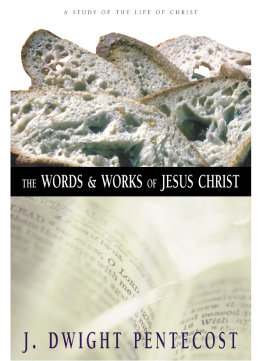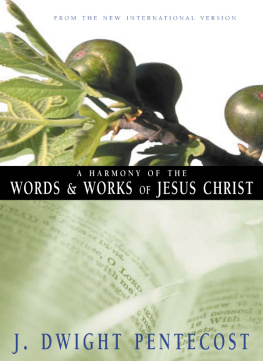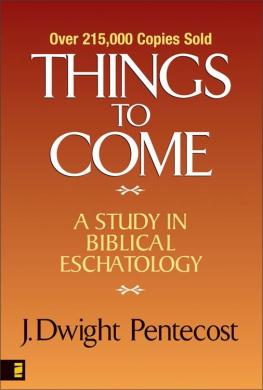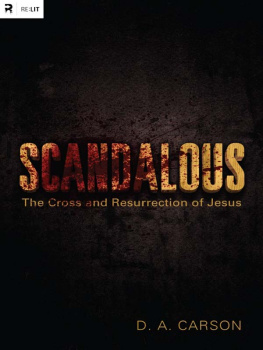ZONDERVAN
The Words and Works of Jesus Christ
Copyright 1981 by Zondervan
ePub Edition August 2016: ISBN 978-0-310-53104-3
Requests for information should be addressed to:
Zondervan, 3900 Sparks Dr. SE, Grand Rapids, MI 49546
Library of Congress Cataloging-in-Publication Data
Pentecost, J Dwight.
The words and works of Jesus Christ /
Bibliography: p.607
ISBN 978-0-310-30940-6
1. Jesus ChristBiography. 2. Christian biographyPalestine. I. Danilson, John. II. Title.
BT301.2.P45 232.9'01[B] 80-22350
All Scripture quotations, unless otherwise indicated, are taken from The Holy Bible, New International Version, NIV. Copyright 1973, 1978, 1984, 2011 by Biblica, Inc. Used by permission. All rights reserved worldwide.
Any Internet addresses (websites, blogs, etc.) and telephone numbers in this book are offered as a resource. They are not intended in any way to be or imply an endorsement by Zondervan, nor does Zondervan vouch for the content of these sites and numbers for the life of this book.
All rights reserved. No part of this publication may be reproduced, stored in a retrieval system, or transmitted in any form or by any meanselectronic, mechanical, photocopy, recording, or any otherexcept for brief quotations in printed reviews, without the prior permission of the publisher.
Edited by John Danilson
Cover and interior design by Stanley N. Gundry
15 16 17 18 55 54 53 52 51 50 49 48 47 46 45 44
To Him
who loves us,
and released us from our sins by His blood,
and He has made us to be a kingdom,
priests to His God and Father;
to Him be the glory and the dominion
forever and ever
(Rev. 1:56 NASB )
and
to my wife
her worth is far above jewels
(Prov. 31:10 NASB )
Contents
It has been my inestimable privilege for some thirty years to teach a course on the life of Christ, first at Philadelphia College of Bible and now for a quarter of a century at Dallas Theological Seminary. This has been a life-transforming experience, for one cannot study the Gospels extensively without being changed by the Person they present. Those who give themselves to the words and works of Jesus Christ cannot help but be drawn to Him. This author is profoundly grateful for the privilege of such study and for the opportunity to present the fruits of that study to a multitude of students. The response to this presentation has encouraged the author to heed their insistence that the material be made available in written form.
In my earlier years of teaching, I followed the traditional geographical approach to the study of the life of Christ. It became evident that this procedure obliterated the essential theme of the Gospels. Jesus Christ came to the nation Israel to present Himself as the promised Messiah and to offer that nation the covenanted kingdom in which He would rule as Savior-Sovereign in peace and righteousness. A geographical division of His life did not develop this theme.
It becomes evident to one who approaches the inerrant Scriptures from a literal method of interpretation that Jesus Christ was introduced to the nation Israel as her Messiah. By His words and His works He authenticated this introduction and offered Israel her promised and covenanted kingdom. The nation considered the offer and, because of the opposition of the leaders, rejected it. Christ announced judgment on that nation and turned from a public ministry to that of preparing chosen men to continue His ministry following His death and resurrection. The rejection by the nation led to His death, by which salvation was provided for sinful men; but the genuineness of His offer was authenticated by the Resurrection. It is this theme that will be developed through this work. While there are many works available on the life of Christmore than one can study in a lifetimenone traces the development of this theme, and this gives warrant for another work in an area where there is already an abundance of material available.
As consideration is given to the gospel record, no attempt can be made to give a verse-by-verse exposition of each incident. Rather, an attempt will be made to trace the development and the presentation of the person and work of the Lord Jesus Christ and to show the contribution that each individual incident makes to the overall development.
Deep appreciation is expressed to Dallas Theological Seminary for the sabbatical leave granted to pursue this work, to the many students who gave encouragement to undertake this project, to Miss Nancy Miller for transcribing the tapes of the material, and to the staff of the Faculty Secretaries Office for their work in typing the manuscript. The author acknowledges the contributions of past scholars, many of whose insights he quotes. Unless indicated otherwise, all Scripture quotations are from the New International Version.
This book is provided for those who desire to study the words and works of Jesus Christ. It is presented with the prayer that the study may lead them into a deeper knowledge of Him of whom the Scriptures speak and into a closer walk with Him whose love is revealed in all His words and works.
J. Dwight Pentecost
Dallas, Texas
The apostle John, having recorded a portion of the words and works of Jesus Christ, concluded his Gospel by saying, Jesus did many other things as well. If every one of them were written down, I suppose that even the whole world would not have room for the books that would be written (John 21:25). John was overwhelmed at the enormity of the task that lay before him as he sought to sift through the extant material in order to present the pertinent truths that suited his purpose to lead men to faith in Christ. How much more is one overwhelmed today as he writes from the present perspective and views the enormity of the task that lies before him in seeking to trace the theme of the life of Christ as presented in the Gospels!
The shelves of our libraries are filled with tens of thousands of volumes written on both the words and the works of Jesus Christ. To sift through all this material would be impossible in a single lifetime. The Gospels have been studied from many viewpoints: historically, geographically, analytically, ex-positionally, critically, devotionally, doctrinally, and practically. Even with all of this, surprisingly little attention has been given to the person of Christ as revealed in the Gospels or the program in which Christ was involved during His stay on the earth. Shepard notes:
Christianity is a historic religion because Christ, its founder, was a historic person. In the beginning of the Christian era there appeared in history One who changed its current from a downward to an upward trend. He was born in Bethlehem and reared in Nazareth in a small town of Galilee, of an humble family of the Jews who were then subjected under the provincial Roman rule.
He received His elementary training in a synagogue school in which the Jewish child studied from the ages of six to twelve. Although the people of Galilee enjoyed more liberality in religion than those of Judea, the Jewish religion everywhere was oppressed by a narrow, Rabbinical leadership which headed up in Jerusalem. The boy Jesus had no highly literary education but became well grounded in Aramaic, and in the knowledge of the Hebrew language and the Sacred Scriptures of the Jews. He mastered also Greek into which these Scriptures had been translated centuries before His time. While supporting as a carpenter the family of the deceased Joseph He cut His way forward in the mastery of the Rabbinical lore and the Hebrew prophets, becoming deeply learned in the true religion of Israel. At the age of thirty, He appeared at the Jordan, asking baptism of John, and soon after He initiated His ministry, which grew into a religious movement, that has reached today the uttermost confines of the world.












